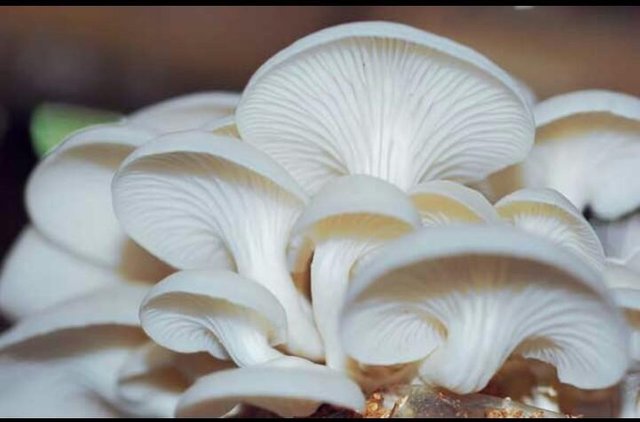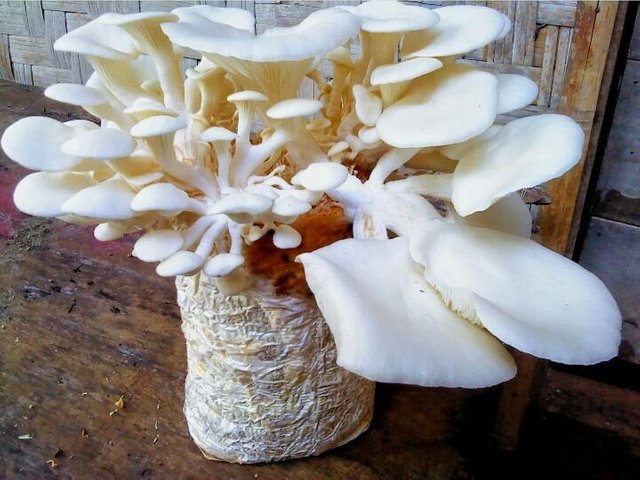Oyster mushroom
This time I will share information about oyster mushrooms. Check it out!


Oyster mushroom (Pleurotus ostreatus) is a food fungus from the Basydiomicota group and belongs to the Homobasidiomycetes class with the general characteristics of the white fruit body to the beige and the semicircular hood resembling an oyster shell with a slightly concave center.Oyster mushroom is often known as King Oyster Mushroom.
The oyster mushroom body has a sideways grove (Latin: pleurotus) and oyster-shaped (ostreatus) so that oyster mushrooms have the binomial name Pleurotus ostreatus.The hood part of the fungus changes color from black, gray, brown, to white, with a surface that is almost slippery, 5-20 cm diameter edge edged smoothly slightly curved.In addition, oyster mushrooms also have a rod-shaped spore measuring 8- 11 × 3-4μm and white miselia that can grow quickly.
In the wild, oyster mushrooms can be found almost throughout the year in the cool mountainous forests of the region.The body of the fruit seen overlapping on the surface of the tree trunk that has been decayed or the stem of a tree that has been felled because oyster mushroom is one type of wood fungus. For that, when want to cultivate this mushroom, the substrate must be made to consider the natural habitat.A medium commonly used to breed oyster mushrooms is sawdust which is a waste from sawmill.
Life cycle
In general, oyster mushrooms, Pleurotus ostreatus, have two types of breeding in their life cycle, ie asexually and sexually.As well as asexual reproduction of fungi, asexual reproduction of basidiomycota generally occurring through an endogenous spore pathway in its spore or sporangium sac, its asexual spores called conidiospores are formed in the conidium.[6] While sexually, reproduction occurs through the unification of two types of hyphae which act as male gametes and females form a zygote which then grows into adult primodies. [6] Sexual spores in white oyster mushrooms, also called basidiospores located in the basidium sac. [6]
At first the basidiospores mimic form a monocharyotic mycelium, the mycelium with the haploid nucleus. [6] The mycelium continues to grow until the hyphae in the mycelium fuses with other compatible hyphae causing plasmogamy to form a dikaryotic hyphae. [7] After that when environmental conditions permit (temperatures between 10-20 ° C, moisture 85-90%, sufficient light, and CO2 <1000 ppm) then the fruit body will form. [8] The formation of the fruit body accompanied the occurrence kariogami and meiosis in the basidium. [7]
The meiotic haploid nucleus then migrates to tetrad basidiospores in the basidium. [7] This basidium is located on a slab or bulkhead in a large number of adult mushroom hoods (lamela). [6] From this detached spore will develop into a mono-phonic hyphae. [6] This hyphae will lengthen its filament by forming a branch of the formation of two nuclei bounded by a septum (one septum a nucleus). [6] Then the mono-mononic hyphae will accumulate to form a white connecting connective tissue called the early mycelium and eventually grow into adult mycelium (a collection of hyphae dikarion). [6] In this stage, hyphae have undergone plasmogami, kariogami, and meiotic stages to form mushrooms. [6] Later, the fungus can now be directly harvested or re-prepared into a parent seed [6].
You like the article I created? Please vote :)
Do not forget also share, comment, re blog, and follow me @memeddewi
Thank you very much :)